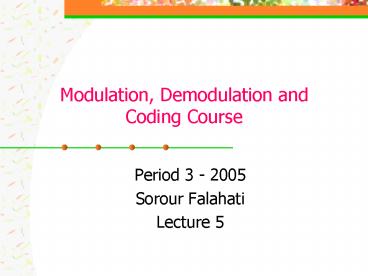Modulation, Demodulation and Coding Course PowerPoint PPT Presentation
1 / 15
Title: Modulation, Demodulation and Coding Course
1
Modulation, Demodulation and Coding Course
- Period 3 - 2005
- Sorour Falahati
- Lecture 5
2
Last time we talked about
- Signal detection in AWGN channels
- Minimum distance detector
- Maximum likelihood
- Average probability of symbol error
- Union bound on error probability
- Upper bound on error probability based on the
minimum distance
3
Today we are going to talk about
- Another source of error
- Inter-symbol interference (ISI)
- Nyquist theorem
- The techniques to reduce ISI
- Pulse shaping
- Equalization
4
Inter-Symbol Interference (ISI)
- ISI in the detection process due to the filtering
effects of the system - Overall equivalent system transfer function
- creates echoes and hence time dispersion
- causes ISI at sampling time
5
Inter-symbol interference
- Baseband system model
- Equivalent model
6
Nyquist bandwidth constraint
- Nyquist bandwidth constraint
- The theoretical minimum required system bandwidth
to detect Rs symbols/s without ISI is Rs/2
Hz. - Equivalently, a system with bandwidth W1/2TRs/2
Hz can support a maximum transmission rate of
2W1/TRs symbols/s without ISI. - Bandwidth efficiency, R/W bits/s/Hz
- An important measure in DCs representing data
throughput per hertz of bandwidth. - Showing how efficiently the bandwidth resources
are used by signaling techniques.
7
Ideal Nyquist pulse (filter)
Ideal Nyquist filter
Ideal Nyquist pulse
8
Nyquist pulses (filters)
- Nyquist pulses (filters)
- Pulses (filters) which results in no ISI at the
sampling time. - Nyquist filter
- Its transfer function in frequency domain is
obtained by convolving a rectangular function
with any real even-symmetric frequency function - Nyquist pulse
- Its shape can be represented by a sinc(t/T)
function multiply by another time function. - Example of Nyquist filters Raised-Cosine filter
9
Pulse shaping to reduce ISI
- Goals and trade-off in pulse-shaping
- Reduce ISI
- Efficient bandwidth utilization
- Robustness to timing error (small side lobes)
10
The raised cosine filter
- Raised-Cosine Filter
- A Nyquist pulse (No ISI at the sampling time)
Roll-off factor
Excess bandwidth
11
The Raised cosine filter contd
1
1
0.5
0.5
0
0
12
Equalization
- ISI due to filtering effect of the communications
channel (e.g. wireless channels) - Channels behave like band-limited filters
- Equalization is a technique to remove ISI caused
by the channel
Non-constant amplitude Amplitude distortion
Non-linear phase Phase distortion
13
Equalization contd
Step 1 waveform to sample transformation
Step 2 decision making
Demodulate Sample
Detect
Threshold comparison
Frequency down-conversion
Receiving filter
Equalizing filter
Compensation for channel induced ISI
For bandpass signals
Baseband pulse (possibly distored)
Received waveform
Sample (test statistic)
Baseband pulse
14
Equalization contd
- Equalization using
- MLSE (Maximum likelihood sequence estimation)
- Filtering
- Transversal filtering
- Zero-forcing equalizer
- Minimum mean square error (MSE) equalizer
- Decision feedback
- Using the past decisions to remove the ISI
contributed by them - Adaptive equalizer
15
Pulse shaping and equalization to remove ISI
No ISI at the sampling time
- Square-Root Raised Cosine (SRRC) filter and
Equalizer
Taking care of ISI caused by channel

